Here is the list of the 10 most Common ZZ Plant Problems. Take note and go through the detailed article to keep your beloved plant healthy!
These are the most Common ZZ Plant Problems with their detailed solutions. Knowing them will help you to keep your plants safe and healthy.
Read about the raven ZZ plant care tips here
Common ZZ Plant Problems and Solutions
1. Stunted Growth

- If your indoor ZZ plant is not producing new leaves, the most potential cause would be insufficient light. This houseplant prefers bright, indirect sunlight; hence locate the plant accordingly.
- The growing season of this hard-to-kill plant occurs from early spring to mid-fall. It is substantially enforced by lighting; you can stretch it by keeping the plant under grow lights.
Note: In equatorial climates, the ZZ plant grows year-round.
If you provide the plant with sufficient light yet it shows signs of stunted growth, check the below problems:
- Root Bound: When roots fill the pot, and there is no room left to grow, the plant shows no interest in producing new shoots and foliage due to the absence of enough growing medium around the root system.
If you notice roots popping from the drainage hole or spreading above the surface–re-pot it in a 1 or 2 sizes bigger container.
- Overfeeding or Overused Soil: Too much fertilization can damage the roots and lead to stunted growth. The ZZ plant requires feeding a few times a year for proper growth.
Similarly, growing in the same soil for years deplete the nutrition in the growing medium-this can be the reason as well.
In case of overfeeding, flush the soil. If the plant is not fertilized or repotted in many years, apply some fertilizer to promote growth.
- Lack of Acclimation: ZZ plant requires 4-6 weeks to adapt to the new conditions and will not thrive in this phase. Make your plant comfortable by slowly acclimatizing it to a new atmosphere.
- Stress, Pest, and Diseases: Stressed plants from cold drafts or affected by pests can also prevent new foliage growth.
2. Leaves Turning Yellow

- Overwatering: It results in leaf yellowing, and you see plant edema symptoms on the lower and old foliage, especially the undersides.
Once the root rot spreads–you see brown leaf tips with some mushiness, soft wrinkled leaves, drooping stems on new growth, and a foul odor of rotten roots. Fix this issue by watering the plant only when the topsoil dries. - Newly Purchased Plant: You can see yellow foliage or leaf drop in these plants as they try to adapt to different set up of your home. This can also be seen after repotting.
- Excessive Light: This can also cause yellow and papery leaves, so place the plant in indirect bright light.
- Low Light: Zz plant’s leaves appear faded, less perked up, and soft due to low light. If you notice these symptoms, observe the location and shift the plant somewhere where it can soak more light.
3. Brown Tips
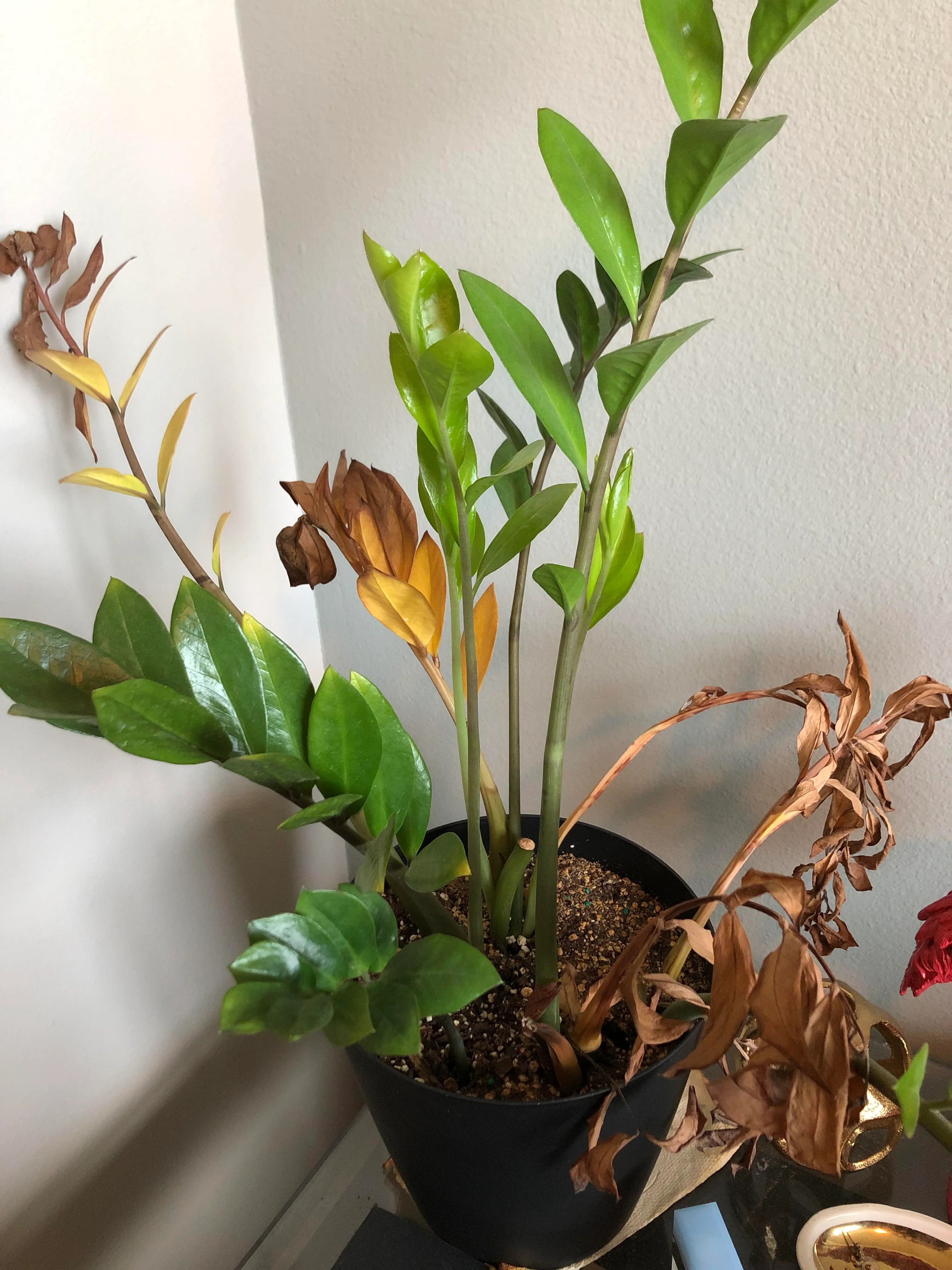
- Overwatering can cause brown tips on ZZ plants, mainly on new growth. To avoid this, water the plant when the soil becomes dry and ensure the pot has sufficient drainage holes.
- Cold or Hot Air can also cause brown tips. Keep the plant away or protect it from A/C or heating vents.
- Low Humidity and dry air around the plant can also turn the leaf tips brown. Solve the problem by keeping the ZZ plant in an area with ideal relative humidity.
Fortunately, this low-maintenance plant doesn’t need very high humidity, but peak winter and summertime (in hot climates) have dry air issues. - Excessive Light: Too much sunlight can result in heat and evaporation, and the plant loses water from the foliage. Hence locate the ZZ plant away from direct sun, especially in the afternoon.
Find out some science-backed benefits of growing ZZ plant here
4. Floppy / Drooping Stems
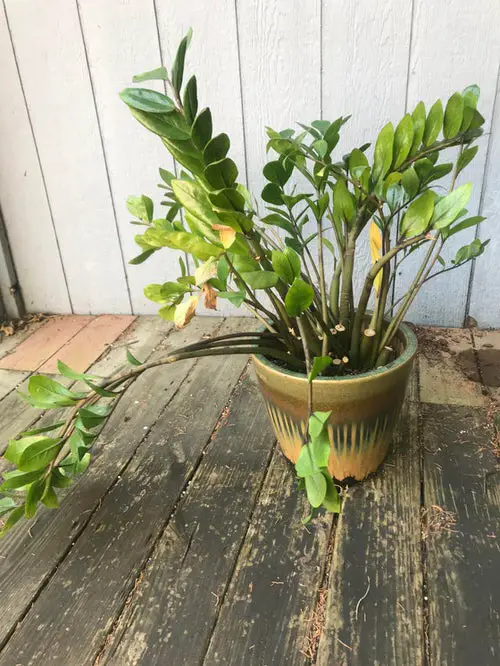
- Low light causes this issue. To overcome this, rotate the plant every week so light reaches evenly on every part of the plant.
- The other main reason behind this issue is overwatering, which makes the stems soft, making them incapable of supporting the weight of the remaining plant.
- Transplant shock after repotting is also one of the reasons. Right after repotting, support the plant by tying its stem to bamboo sticks.
- Temperature Stress due to low or high temperatures may lead to this too.
5. New Growth is Light Green
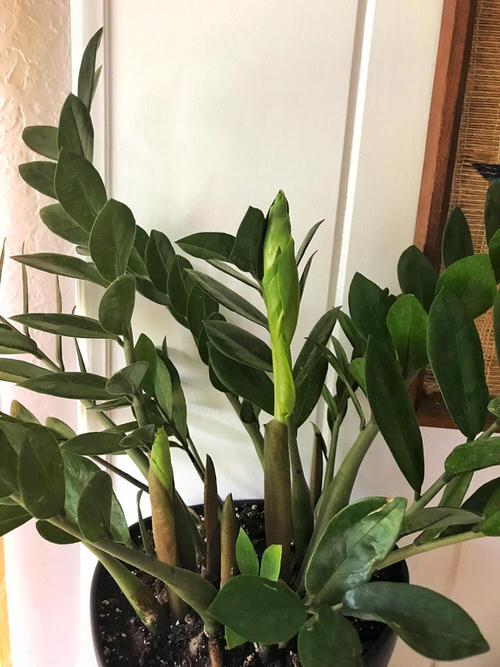
A light green new growth is common in ZZ plants. If the leaves stay fragile or don’t turn dark in color with time, then it can be due to nutrient deficiency.
To solve this issue, feed it with a balanced liquid fertilizer, diluted to 1/4 of its recommended strength, once in 4-6 weeks.
6. Exposed Root Bulb

When the soil gets washed away from watering too quickly and aggressively, the top roots are exposed. Overhead watering can also cause this issue.
- Water at the base of the plants slowly and avoid watering from the top.
- If the plant is root bound, re-pot it in one size bigger pot.
Check out the best ZZ plant varieties here
7. Wrinkled Stems
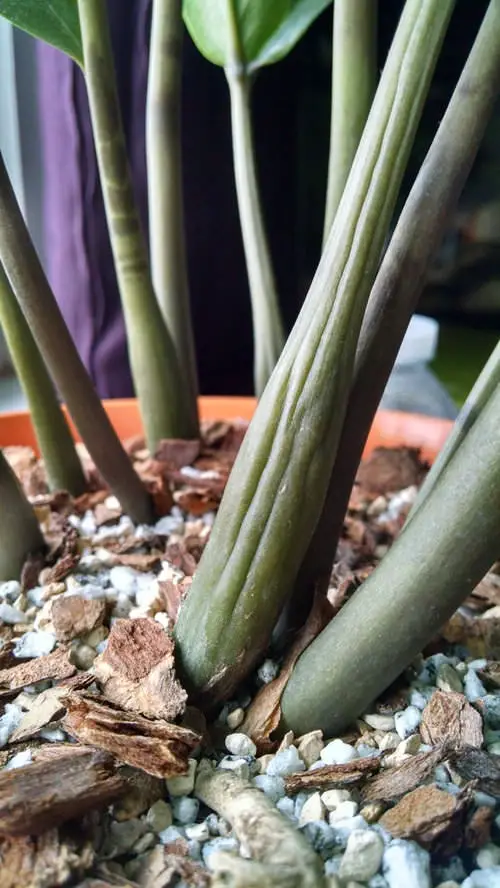
Water deficiency results in wrinkled stems. It also can happen due to too much light, low humidity, underwatering, root rot due to overly moist soil, and high temperature.
First, know about the cause and opt for the solution accordingly.
8. Root Rot

Poorly aerated and waterlogged soil can become oxygen-deficient, putting the roots under severe stress. Early signs of root rot can be treated, but severe cases cannot be fixed.
- Soft brown leaf tips, affecting the new foliage
- Yellow mushy leaves in lower and old foliage
- Signs of edema or leaf blisters
- A rotting odor from the roots
- Drooping or falling stems due to dehydration or rot
- Wrinkled limbs and leaf curling when roots cannot provide enough water to the plant.
Follow the Below Steps to Treat Root Rot in ZZ Plant
- Take out the ZZ plant from its container.
- Gently loosen the soil and check for black/brown, fragile, mushy, stinking roots.
- Trim off the affected roots with clean pruners.
- Rinse the remaining soil from the roots, and use fresh potting mix for re-potting. Also, use a new pot.
Is Zz plant toxic to cats? Learn here
9. Leaf Curling

Zz plant’s leaves curl to minimize the surface area of the foliage, thus reducing water loss.
- Light: Too much direct light causes greater water loss, inducing the plant to curl the foliage. Locate it where it gets plenty of bright but indirect light.
- Watering: Search for the signs of over or underwatering. Water the plant deeply until it seeps out from the drainage hole when the topsoil feels dry to the touch.
- Humidity: Keep it in a cool area, group it with other plants, or place its pot on a tray filled with water and pebbles.
10. Lackluster Foliage
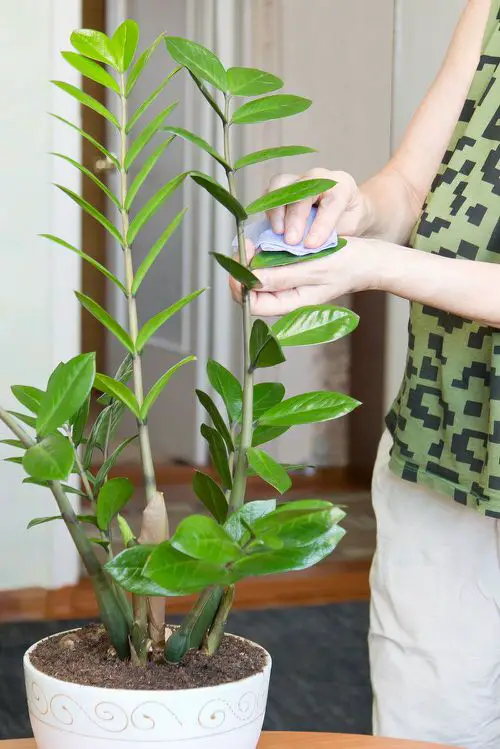
The glossy and dark leaves of the plant lose their shine over time due to the accumulation of dust. It makes the plant appear dull.
To overcome this issue, simply wipe the leaves with a damp cotton cloth once a week. It will keep the surface of the foliage shiny, which will also help the plant with photosynthesis.



Where to get baby ZZ plants…